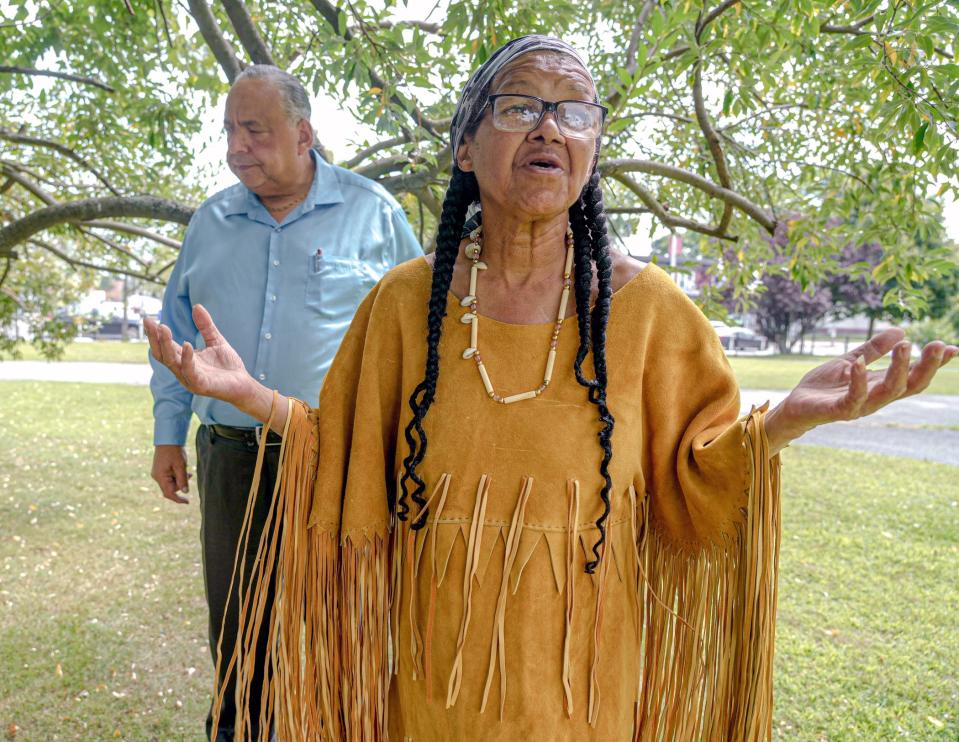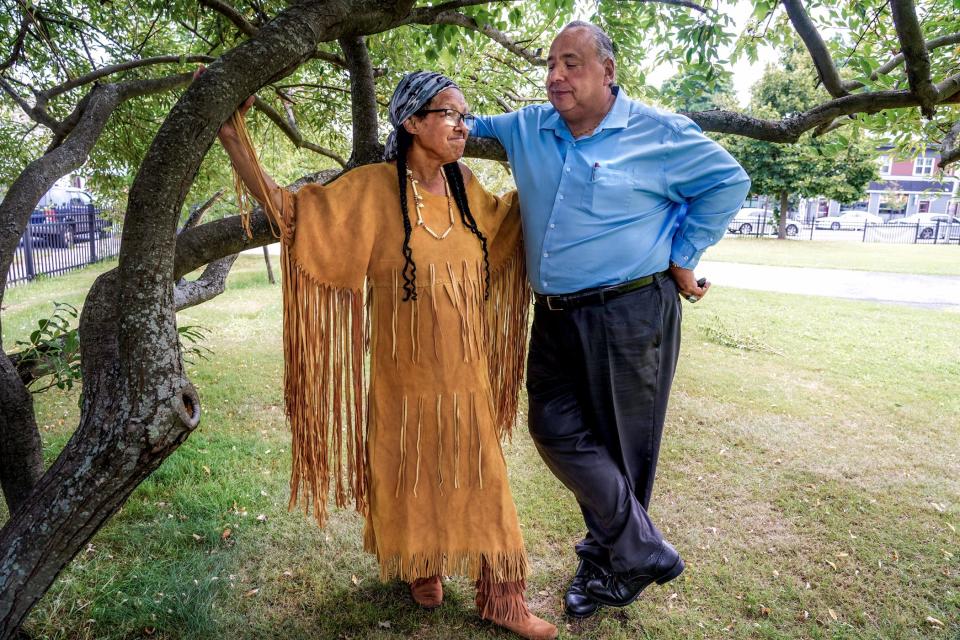RI parks have statues of generals and war heroes. She wants to add Native leaders to that list
PROVIDENCE – A vision took root for Diana Gray in June 2020 as the City of Providence removed its Christopher Columbus statue after repeated bouts of vandalism and protests from the square where it had stood for more than a century.
She wants to see statues honoring historic Native American leaders displayed in city parks and serving as vehicles to inform and educate Rhode Islanders about the state’s rich Indigenous history and draw visitors to the Ocean State. They would represent the tribes that long inhabited the region, including the Narragansett, Nipmuc, Wampanoag, Pequot and Niantic.
A blend of Pequot and Narragansett, 73-year-old Gray, whose Native American name is Weeping Willow, has made T-shirts and pins to help raise money for the endeavor. She sent the pins to state and local leaders and plans to set up a booth at WaterFire Providence on Sept. 9 to spread the word.
“Providence will be the only city to have it. It will educate people,” said Gray, who envisions buses full of students touring the sites and learning the legacy of Native Americans in Rhode Island.
She knows it’s a big undertaking, but she's determined to see it through.

A vision with backing
The effort has the support of the Rhode Island Indian Council, a nonprofit organization that promotes the social, economic and cultural well-being of tribal communities.
“Rhode Island was Native before, and they took it from them,” said Darrell Waldron, executive director of the council and chief of the Seaconke Wampanoag Indian Tribe. “This country was invaded. The Indians were executed."
Waldron believes the time is ripe for Americans and Rhode Islanders to learn more about Native traditions, history and culture – as well as the grave poverty and historical trauma that persists in tribal communities.
“People only have an image of cowboy movies in the '60s. It’s unfortunate, but I think that’s the image,” Waldron said in a recent interview at the council’s offices at 807 Broad St.
“We’re here trying to clean up that mess … I think Americans would be appalled at what was done to the Native people,” said Waldron, whose agency has helped Native Americans achieve economic independence and social well-being since 1975 through job training and social programming. Its service area encompasses Rhode Island, Connecticut, Delaware, New York and New Jersey.
More on Native Americans in Rhode Island Proposal would create process for Rhode Island to recognize Native American tribes
`It’s hard to let things go because of what happened to our ancestors'
Gray believes the project would prove a boon to the city, bringing in people to stay in hotels and dine in restaurants. She acknowledges the painful past, but is intent on sharing an image of Native Americans that reflects the strength of when tribal leadership ruled the lands.
“It’s hard to let things go because of what happened to our ancestors,” Gray said this week, wearing regalia made of soft buckskin.
Gray has reached out to the city Department of Art, Culture and Tourism and submitted an application, and hopes to garner philanthropic support.
According to Josh Estrella, spokesman for the city, all statues in city parks need to be approved by the Board of Park Commissioners, and Gray's project has not yet been discussed or authorized.
Waldron remains incensed at what he sees as the state's lack of acknowledgment of the contributions of Indigenous people and the gravity of what befell those communities at the hands of Europeans.
“It angers me every day,” he said. “I just think they are out of sight and out of mind. They keep wanting to sweep Indian issues under the rug.”
Gray’s concept of placing the statues in parks and creating a tour would represent a tangible way to educate people about Indigenous history and culture and shift the controversy about Columbus to something more positive, she says.

Columbus statue finds a new home in Johnston
Made in Providence in 1893 by Auguste Bartholdi, the sculptor of the Statue of Liberty, the Christopher Columbus statue came down in June 2020 after years of vandalism and outcry from critics that the explorer represented genocide and slavery. Dozens of monuments were toppled around the same time during a period of national reckoning following the murder of George Floyd, including a sculpture of Confederate Gen. Robert E. Lee in Richmond, Virginia.
The Columbus statue was placed in storage until being sold for $50,000 to former Providence Mayor Joseph Paolino Jr., who called it "a symbol of Italian culture."
It will now have a home in Johnston Memorial Park because Mayor Joseph Polisena Jr. agreed to host it. The statue will be surrounded by fence and guarded from vandalism by security cameras.
Polisena’s office said United Fence and Mt. Pleasant Alarms offered to install the equipment free of charge. The town is expected to unveil the statue on Columbus Day.
Polisena has contended that there was widespread "mistreatment across the globe” in the time of Columbus.
"I think he is an important historical figure and I understand people think he comes with controversy," Polisena said. "But my response to that is, I’m not going to judge people who lived over 500 years ago based on modern societal norms today."
Paolino credited Polisena with “playing an important role to ensure that this historical symbol is not melted down and turned into scrap metal.”
“We cannot run away from history. The Christopher Columbus statue is a source of pride for many families in our state," he continued.
Providence City Councilman James Taylor told ABC6 News that the money would be used within the Elmwood neighborhood. Taylor also said the city should have held out for a higher bid than Paolino's, as the statue’s worth had been estimated as high as $500,000.
The Board of Park Commissioners sold the statue to Paolino "under the condition that it would be well preserved, protected, and not be damaged, altered, manipulated, or melted down in any way," with no restrictions on public display in the purchase agreement, according to Estrella, the spokesman.
Gray and Waldron would like to see the money go toward the Native American statue project. The Rhode Island Indian Council will hold donations to the project in escrow, Waldron said.
“It’s just time to do this,” Waldron said.
Donations can be sent to the Rhode Island Indian Council at 807 Broad St., Providence, RI 02907, attention Darrell Waldron Native Historical Statues.
Providence Journal reporter Amy Russo contributed to this report
This article originally appeared on The Providence Journal: RI woman wants statues in Providence parks of Indigenous leaders

